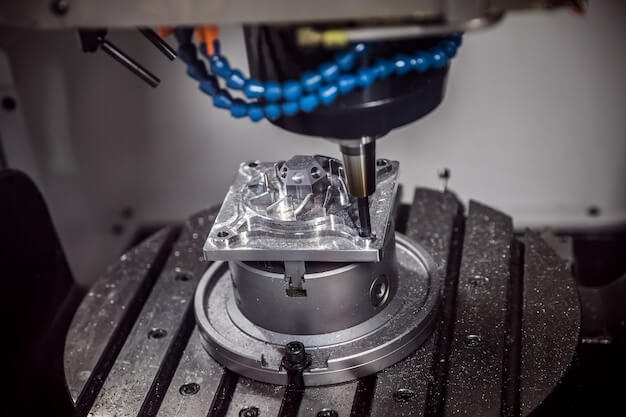Introduction to Compression Molding
Compression molding is a high-volume, high-pressure manufacturing process that transforms raw materials into usable shapes through the application of heat and pressure. This article aims to delve into an in-depth understanding of this critical manufacturing technique by covering its basic principles, including components involved, operations, typical applications, and advantages. Throughout this piece, we will explore how this versatile method presents practical solutions within various industries, particularly plastics and rubber production.
What is Compression Molding?
Compression molding, a prevalent method in the manufacturing industry, involves pressing materials into a predetermined shape by applying heat and pressure. This process chiefly uses thermoplastics or thermosetting plastics, though rubber and metal can also be used. While comparable with other techniques such as injection molding, compression molding claims unique advantages. Much simpler in operation, it creates less waste, making it more cost-effective and environmentally friendly than its counterparts. Furthermore, this type of molding makes it possible to design larger, complex parts that may prove challenging for other methods, demonstrating a versatile approach to varied production needs.
Process of Compression Molding
The process of compression molding involves several stages, each with its unique set of requirements. In the initial preparation stage, precise selection of both materials and molds becomes essential for the end-product quality. Additionally, adequately heating the raw material promotes better flowability, which aids in subsequent stages. The following step is the loading phase where preheated material gets placed into the mold cavity. Here, appropriate pressure application controls the final shape and density of the product. Afterward, the cooling stage commences, and this crucial period allows the molded part to solidify fully. Lastly, during the ejection stage, removing the finished product from the mold takes place carefully not to damage the product. Each stage requires meticulous attention, showcasing how intricate the overall process is.
Applications of Compression Molding in Various Industries
Compression molding’s versatility and efficiency make it a preferred manufacturing process across a broad spectrum of industries. Its ability to produce components with high strength and durability requirements positions it as a critical process in the production of a wide range of products.
Automotive Industry
- Car Parts: Fenders, car panels, interior parts, LED lighting housings, engine components, and dashboards.
- Protective Gear: Bulletproof vests for police and military vehicles.
Aerospace Industry
- Aerospace Components: C-channels, H-beams, U-sections, L-stringers, T-strings, O-rings, door and window frames.
- High Strength-to-Weight Ratio Parts: Manufactured using wet compression molding machines, suitable for components requiring complex geometries or high-strength composite materials.
Electrical and Electronics Manufacturing
- Electrical Components: Electrical sockets, motor housing, control panels, switches, faceplates, and metering devices.
Consumer Goods Industry
- Household Items: Utensils, handles & knobs, bowls, cups, plates, decorative vases and containers, bathroom accessories.
- Plastic Tableware: Durable and easy-to-clean options for the food service industry.
Medical Equipment Manufacturing
- Medical Devices and Components: Plastic syringe stoppers, silicone respirator masks, prosthetic limb parts, diagnostic equipment housing, surgical tray components, dental device parts.
| Industry | Applications |
|---|---|
| Automotive | Car parts, Protective gear |
| Aerospace | Aerospace components, High strength-to-weight ratio parts |
| Electrical & Electronics | Electrical components |
| Consumer Goods | Household items, Plastic tableware |
| Medical Equipment | Medical devices and components |
These applications demonstrate the adaptability of compression molding in meeting the diverse needs of various industries, producing not only functional but also high-quality components that adhere to strict standards.
Advantages and Disadvantages of Compression Molding
In terms of benefits, compression molding is a popular choice for manufacturers because it’s cost-effective for low-volume production. This method significantly reduces the waste of material, leading to increased savings. It is also particularly suitable for producing larger, complex parts due its higher pressure capacity. However, this method does have some drawbacks. One key disadvantage includes slower production speeds compared to other methods such as injection molding which could impact timeline of production. The second limitation lies in its design flexibility – the process isn’t ideal for creating intricate or detailed designs. Thus, while it proves beneficial for manufacturing simpler, large-scale components cost-effectively, its utility can be limited depending on part complexity and volume required.
Related Posts
- What is Compression Molding? Details Explained
Introduction to Compression Molding Compression molding is a widely utilized manufacturing process, especially in the production of various components across multiple industries. This method is particularly favored for its ability…
- Mastering Bead Blasting in CNC Machining(insert molding Edgar)
Bead blasting is a crucial process in the world of computer numerical control (CNC) machining. It’s an efficient procedure for using high-pressure air mixed with tiny glass beads to remove…
- The Future of Manufacturing: Exploring the Potential of Insert Molding in CNC Machining
As the manufacturing industry evolves, innovative techniques such as insert molding are reshaping the landscape of CNC machining. This article delves into the potential of insert molding in CNC machining…








